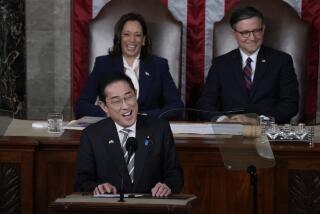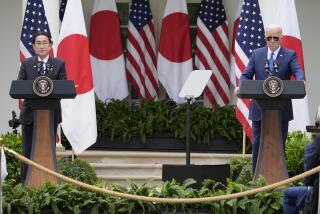Japan’s $124-Billion Stimulus Package Gets Cool Reception
- Share via
TOKYO — In yet another attempt to revitalize Japan’s moribund economy and appease its foreign critics, the ruling Liberal Democratic Party on Thursday announced a $124-billion economic stimulus package touted as the largest in this nation’s history.
However, the package consisted primarily of public works spending and included no immediate promise of the personal income tax or corporate tax cuts that investors--and the United States--have been clamoring for.
Two major Japanese newspapers reported in today’s editions that Prime Minister Ryutaro Hashimoto, in a crucial reversal of his austerity policies, had decided to revise a key law to allow Japan to engage in deficit spending until 2005, paving the way for a tax cut. However, others reported only that tax cuts would be “studied,” and there was no confirmation from the government or word about when and how significant such cuts might be.
Business leaders and financial analysts reacted coolly, noting that critical details of the $124-billion stimulus package had yet to be finalized.
“The headline size has gone beyond most people’s expectations, but it remains to be seen how much is exaggeration and smoke and mirrors,” said Russell Jones, chief economist at Lehman Bros. Japan. “There’s still a lot of skepticism.”
Others said it was far from certain that even the huge sum--$46 billion more than the $78-billion estimate that had been floated in the media earlier this week--would be enough to pry Japanese wallets open.
The Nikkei stock index surged and briefly broke the 17,000 barrier on the news Thursday, but fell back to close at 16,980.62, up 322.28 points or 1.93%. The Japanese yen strengthened by about 0.74 yen to end trading at 128.94 per dollar.
In midday trading today, the Nikkei was off 40.06 points, or 0.2%, to 16,940.56. That left a lengthy distance for the Nikkei to travel to reach 18,000 by Tuesday, the goal of leaders who hope to inflate the value of assets held by Japanese banks to spur more lending in the stagnant economy.
Anxious over economic weakness, a shaky financial system, an aging work force and a so-far-unconvincing government response to such problems, Japanese consumers have dramatically slashed their spending. Department store sales, for example, plunged 6.6% last month and supermarket sales dropped 5% compared with a year earlier.
Critics of Hashimoto’s austerity policies argue that only massive tax cuts could now persuade consumers to start buying again, and thus prompt Japan to import the goods that crisis-racked Asian economies desperately need to export.
Liberal Democratic Party (LDP) officials acknowledged their party remains divided over the questions of whether, how and how much to cut taxes. They left open the possibility that tax cuts might be approved later,--perhaps before Hashimoto’s departure for a Group of Seven industrialized nations’ summit in London in mid-May.
Since the Asian economic crisis began last fall, U.S. officials have been steadily ratcheting up the verbal pressure on Japan to rescue its own economy and become an engine of economic growth for the rest of Asia. Last week, an irritated Hashimoto finally fired back.
“We understand the need for temporary [stimulus] measures without being told by other countries, and we have been working hard on this,” Hashimoto said. “And I feel that there are cases when what foreign countries demand is not a plus for Japan.”
However, unlike the unwanted foreign pressure on Japan over trade issues, many business people, and even some senior LDP politicians, say they agree with the Americans.
“It is true that Japan needs several trillion yen worth of tax cuts,” said Junji Ohta, financial analyst at Okasan Research Institute. “In that sense, I don’t think the United States has been so demanding or unreasonable.”
A poll by the Nikkei financial daily this week found that 65% of those surveyed favored tax cuts to boost the economy.
The LDP settled on the $124-billion figure because it amounts to a hefty 3% of gross domestic product, according to the party’s general affairs secretary, Yoshiro Mori. However, whether it will satisfy foreign or domestic investors will depend in part on how much of the money is really “new” spending and how much consists of accounting gimmicks or measures that have already been announced. LDP officials said details of the proposal will not be hammered out until next month.
The outline released Thursday calls for spending some 80% of the 1998 public works budget in the first six months of the fiscal year. And it includes a “strong request”--which in Japan is tantamount to an order--that local governments also increase their public works spending.
Such public works outlays have been the mainstay of the eight previous stimulus packages Japan has introduced since 1992 in an effort to pull itself from the wreckage of the “bubble economy.” The spending typically benefits the construction industry, one of the LDP’s core constituencies, and some say it has been effective in keeping unemployment under 4% despite seven years of recession or lackluster growth.
But spending on pork-barrel projects, from new bullet trains to vast sewer works, has been blamed as a major factor in the ballooning Japanese budget deficit.
But not everyone is convinced that tax cuts would be a magic bullet for Japan’s financial woes.
“Fiscal policy is simply too small to be an engine of growth,” said Ronald Bevacqua, an economist at Merrill Lynch Japan.
Even a 10% tax cut would be worth only 2% of the GDP--and that’s assuming the Japanese didn’t stash the extra cash away in the bank, as they have done with previous tax cuts, Bevacqua said.
The stimulus package announced Thursday also called for unspecified investments in the environment, information technologies and telecommunications; measures to deal with the aging population; and a vague pledge to promote deregulation.
More to Read
Sign up for Essential California
The most important California stories and recommendations in your inbox every morning.
You may occasionally receive promotional content from the Los Angeles Times.













